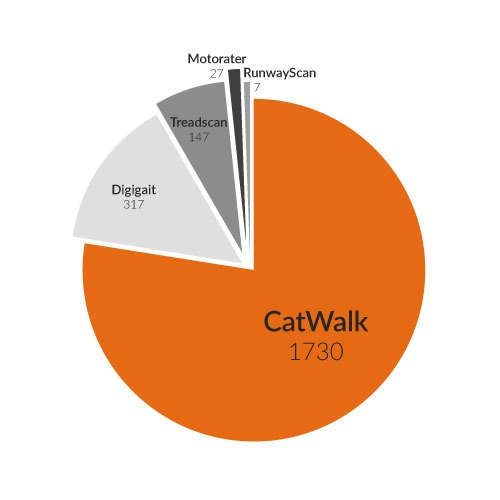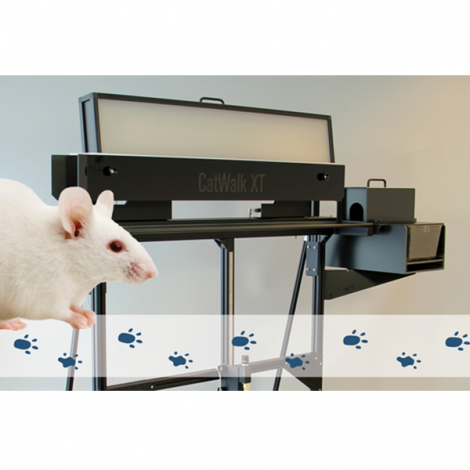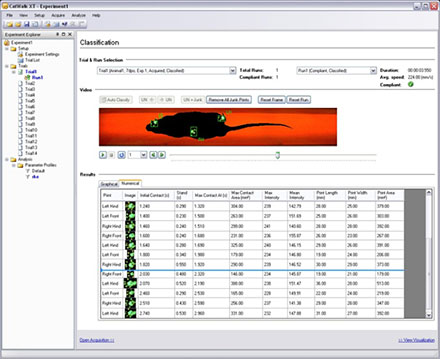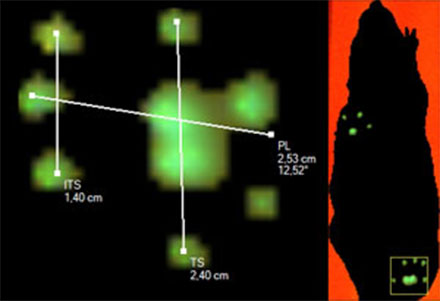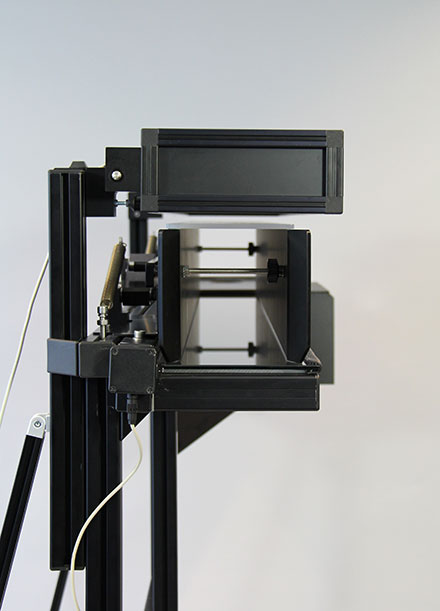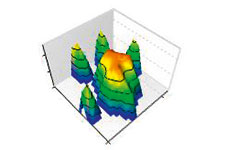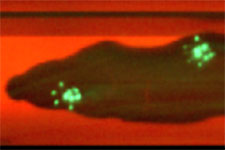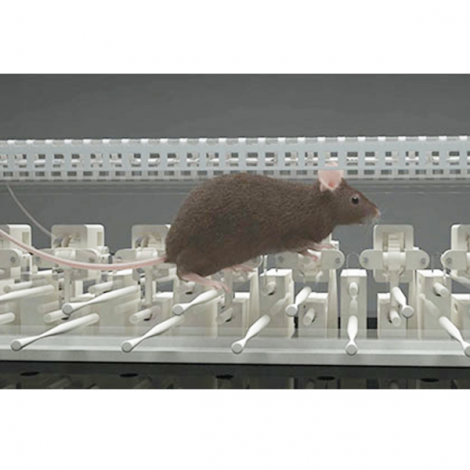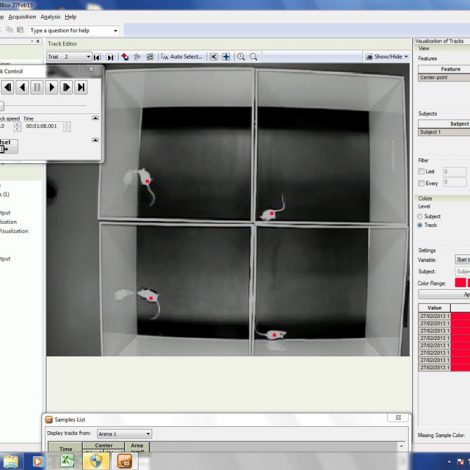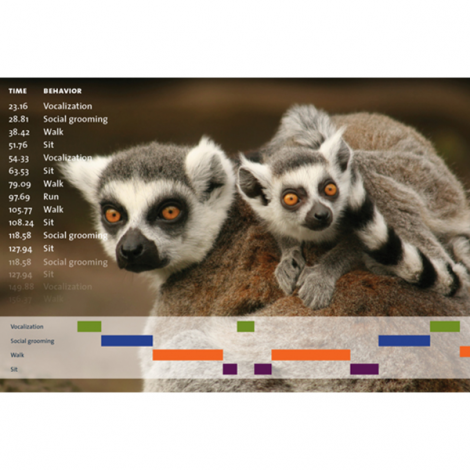CatWalk XT is a complete gait analysis system for quantitative assessment of footfalls and locomotion in rats and mice.
Why use it?
- Quantification of footprints and gait in unforced moving animals
- Accurate and objective data, validated in peer-reviewed research
- Illuminated Footprints: detection of real footprints and body weight distribution
Methodology
The CatWalk XT system detects footprints by video recording the animal from below while it traverses a glass plate. While other methods rely upon error-prone technologies to recognize characteristics of footprints from a video image, CatWalk XT uses the Illuminated Footprints Technology™ to capture actual footprints.
Illuminated Footprints™ technology
So what does this mean? Footprints are illuminated where the paw actually touches the glass. A green LED light emitted inside the glass plate is internally reflected, except at those areas where the animal makes contact with the glass plate. Where the paws touch the glass, light is refracted on the opposite side. The high speed color camera that is positioned underneath the glass plate captures these illuminated areas and sends the data to a computer running the CatWalk XT software.

Advantages of paw print detection
The great advantage of this type of paw print detection is that it is impossible to falsely detect parts of the feet (or of the rest of the body) as part of the print. The system does not overestimate the print size or misinterpret the form. You do not have to black out parts of the body, such as the knees, to prevent false identification.
In addition, if more body weight is exerted on a particular paw, the corresponding footprint area becomes more fully covered by the sole which results in an increase in brightness. This allows subtle differences in weight bearing between the four paws to be detected.

“Our findings show that the CatWalk method is a very sensitive and objective test to assess motor impairment in the bilateral 6-OHDA rat model. The test was easy to carry out, fast in the execution and objective in its assessment.”
DR. R. VLAMINGS ET AL.|MAASTRICHT UNIVERSITY, THE NETHERLANDS
Adjustable light intensities
The CatWalk XT Control Unit provides power to the red LED lights in the CatWalk XT ceiling, green LED lights along the walkway (which are reflected by the plantar surface of the rodent’s paw), and the camera. In CatWalk XT 10.5, you can connect this unit to your computer with a standard USB cable and control both the red and green LED light intensity from within the software.
Now that you are able to choose the optimal lighting conditions, depending on the intrinsic properties of the animal (weight, size, impairment) and environmental light conditions, you can reach optimal detection of each paw placement. This greatly improved the sensitivity and flexibility of the system.

Automatic detection of classification errors
Footprint classification might be difficult in some animals, such as very heavy or severely impaired animals, even by hand. The software automatically detects classification conflicts. You can select them from a dropdown box, upon which the video automatically jumps to the corresponding time point. You can use the zoom function to look at the print in detail and (re)classify it if needed.
View parameter charts
CatWalk XT 10 contains the possibility to view parameter charts. This provides you with graphs for every parameter you are interested in and have selected in your “parameter profile”. This way it will be very easy to see how gait is changing between your experimental groups, over time. The generated graphs can be exported to either programs such as PowerPoint or as a PDF report.
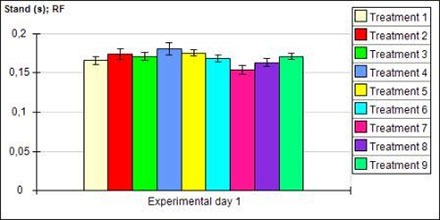
The Illuminated Footprint module
The Sciatic Functional index is commonly used as a tool for the evaluation of the functional recovery of sciatic nerve injury. We have added two extra indices to this module, allowing you to calculate:
- The Tibial Functional Index (TFI), used in the study of tibial nerve injury recovery
- The Peroneal Functional Index (PFI), used in the study of peroneal nerve (also called fibular nerve) injury recovery
The tibial and the peroneal nerve are two branches of the sciatic nerve. Just like the Sciatic Functional Index, these new indices are also calculated based on toe spread, intermediate toe spread, and print length.
Adjust intensity threshold after recording a run
Every paw print will be expressed in a green signal. You can manually change the amount of green signal that is going to be filtered out of each run. Adjusting the intensity threshold allows you, for instance, to filter out noise or overexposed paws. It can also help you to include filtered out parts of a print again.
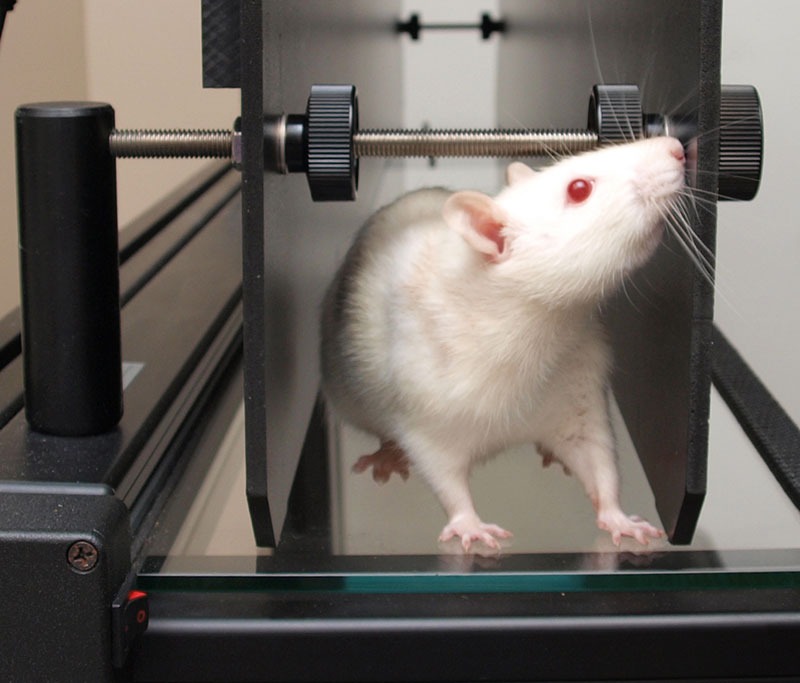
The goal box
The goal box is mounted at one end of the runway and consists of a black shelter with room for a home cage underneath, which the animal can access through a hole. Both motivate your mouse or rat to cross the runway in a consistent manner. This reduces the time it takes to train your animals and improves the quality of the data you acquire during the experiments. With a goal box at the end of the runway including a home cage underneath, the animal is less likely to stop along the way or turn around, motivated by the desire to go to the safety of familiar surroundings. In other words, more runs will be compliant with your run criteria.

Advantages of CatWalk XT
Most cited, compared to other systems and methods
Contrary to what some of our competitors claim, CatWalk XT is by far the most cited gait analysis system. CatWalk XT has been cited at least five times more often than the most cited competing system.
Source: Google Scholar.
